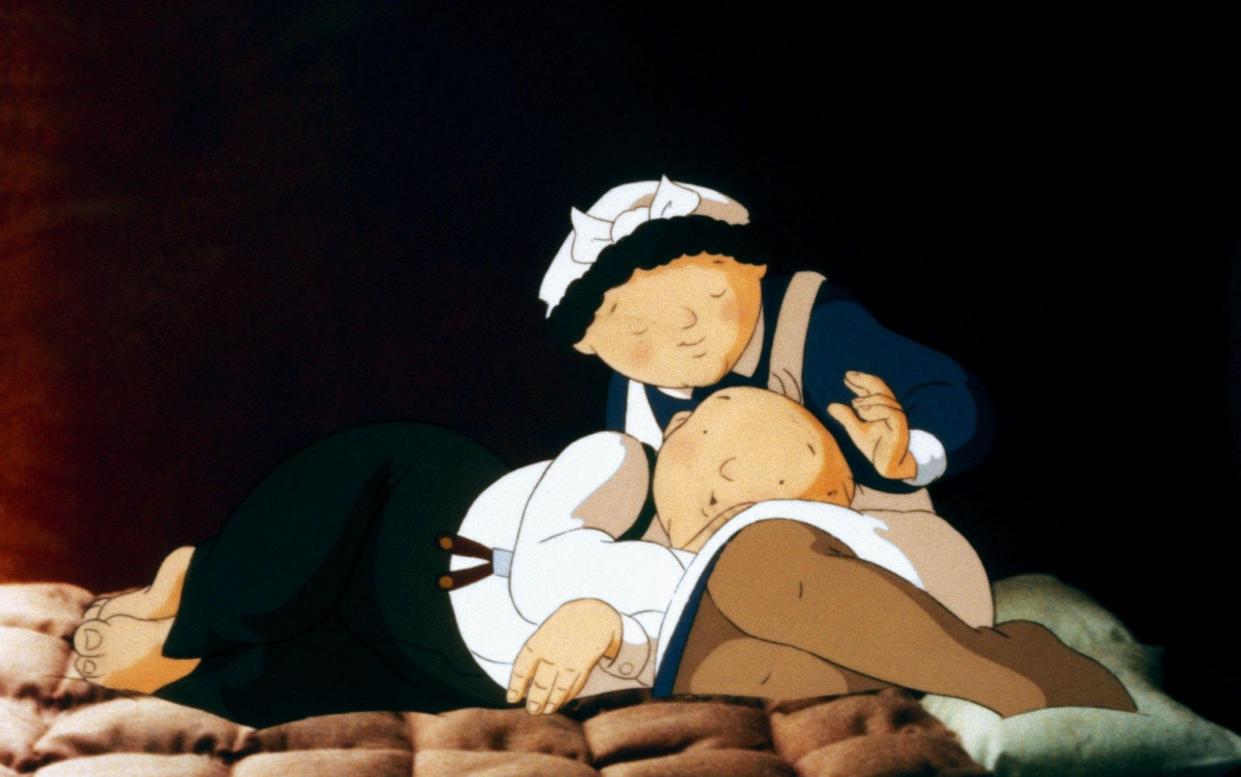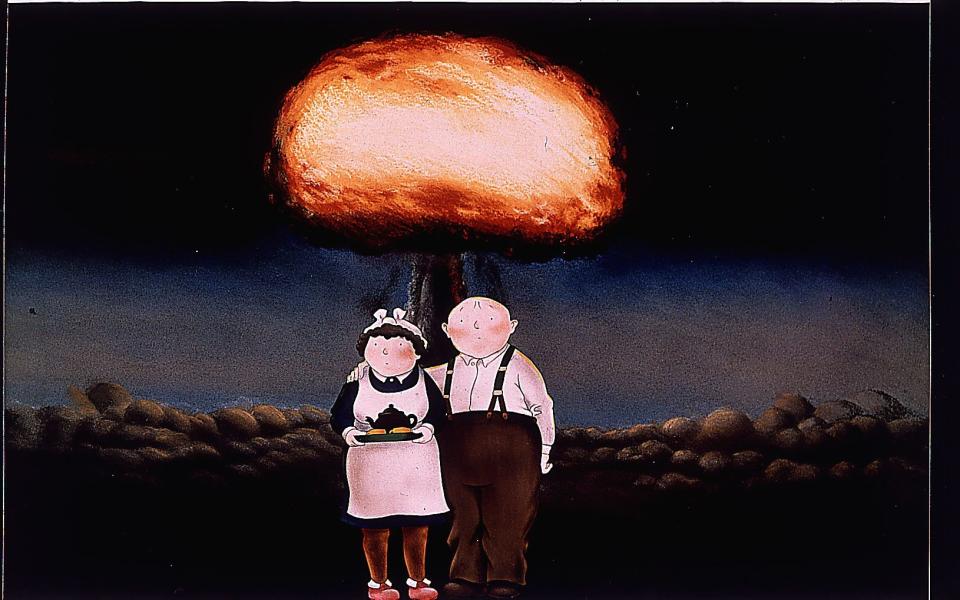Why When the Wind Blows is still Raymond Briggs’s finest – and bleakest – work

Raymond Briggs, who has died aged 88, was, by his own admission, something of a curmudgeon. While generations of children were exhilarated by his seminal book – and subsequent animated film – The Snowman, Briggs himself eschewed sunny optimism for a more realistic, even pessimistic view of the world. He once said: “I don’t believe in happy endings. Children have got to face death sooner or later. Granny and Grandpa die, dogs die, cats die, gerbils and those frightful things – what are they called? – hamsters: all die like flies. So there’s no point avoiding it.”
As the world mourns the death of one of the great imaginative storytellers of the 20th and 21st centuries, most of the headlines have inevitably singled out The Snowman as Briggs’s best-known achievement. Yet it was his follow-up book, and later film, When The Wind Blows, that may be Briggs’s finest work. It combined his peerless artistic and literary skills with a bleak, but never gratuitously unpleasant, narrative that was a world away from the big-hearted optimism of Aled Jones singing Walking In The Air.
When The Snowman was first shown on television on December 26 1982, it became an immediate success, but earlier that year Briggs had demonstrated his versatility by publishing a short, terrifying book that depicted the fallout from a nuclear attack on Britain by Russia. He was inspired by watching a documentary, When The Bomb Drops, which was scathing about Britain’s lack of preparation for nuclear war.
As he said about his work: “Strip cartoons are looked down on in England as a culturally inferior art form but I think that When The Wind Blows at least showed that strip cartoons can deal with a serious subject. It doesn’t have to be about violence or comic cuts. It’s just as good a medium as a film really if it’s used properly.”
Briggs told his story from the perspective of an elderly couple, Jim and Hilda Bloggs, who had previously appeared in his book Gentleman Jim. The Bloggs construct a fallout shelter once they hear government announcements that a nuclear strike is imminent, but thanks to a combination of their naïve trust in the powers that be and the debilitating effects of radiation poisoning, they soon find themselves slowly dying, even as virtually everyone else in the country has been killed instantly. In a typically black comic touch, it is implied that the smell of cooking meat that the Bloggs notice while venturing out comes from the charred corpses of their friends and neighbours.
Briggs published the book at a time when the Cold War showed worrying signs of heating up, and nuclear paranoia gripped the country to an extent that had not been seen since the Cuban Missile Crisis in 1962. He later professed himself surprised by its popularity, saying: “I thought that very few people would be interested in it apart from the peace movement. I never dreamt it would be a bestseller and go on the way it has. On the face of it, it’s rather a depressing story obviously. It concerns two rather uninteresting, fairly unattractive people. There’s no sex in it, no young people, yet it seems to be amazingly popular.”
It had chimed with the zeitgeist, to grim effect. Shortly after When The Wind Blows came out, Mick Jackson’s apocalyptic thriller Threads, depicting the effects of a nuclear attack on Sheffield, was shown on British television, along with a screening of Peter Watkins’s 1966 quasi-documentary The War Game, which was withdrawn from its initial planned screening in the Sixties for being “too horrifying for the medium of broadcasting”.
Even as the world remained terrified by the prospect of sudden annihilation, its fictitious depiction gripped audiences, and so the creative team behind The Snowman, including Briggs, director Jimmy T Murakami and the producer John Coates, reunited for a far more challenging and troubling endeavour.
It had already been adapted for radio (with Wallace and Gromit’s Peter Sallis voicing Jim) and stage, but this would be its most high-profile incarnation. There would be no soaring Aled Jones theme song here, but instead a bleak Roger Waters score, with a high-profile contribution from David Bowie in the shape of the theme song.

When Murakami was asked to direct When The Wind blows, he was delighted. Despite the success of The Snowman, which he later described as “not my cup of tea... I’ll be frank, I’m not one for children’s films”, when he saw the manuscript of Briggs’s follow-up, he said, “this is my kind of film!” and praised it as “a much more serious, adult subject”.
Even as Coates, realising that a jet-black comedy about nuclear holocaust was a tricky commercial prospect, moaned about financing – “Raising money for an animated feature is pure hell,” he complained – it was given a boost by the involvement of Bowie, who, after contributing to The Snowman in the form of a short filmed prologue, offered to write the score to the new film.
Although this eventually became impossible due to Bowie’s ever-hectic schedule, he collaborated with the Turkish musician Erdal Kizilcay on the memorable title track, and later described the film as “a stunning story about an elderly couple who try to survive the release of a nuclear bomb using the government handbook on how to survive a nuclear fallout... it’s a very tragic, sad little movie but it was a good piece to work on.” The remainder of the music featured a Who’s Who of leading British rock acts from the Eighties – Genesis, Squeeze and Hugh Cornwell amongst them – and Waters assembled the so-called “Bleeding Heart Band” to put together the film’s memorably mournful score.
All of this would have been for nothing if it weren’t for the heartbreakingly emotional vocal performances of the veteran actors John Mills and Peggy Ashcroft as the Bloggs. Neither was especially associated with political causes, but both found working on the film an overwhelming emotional experience. As Murakami later recalled: “After the recording there was silence. We – the engineer, John Coates, Raymond Briggs and I – had to recover, choking back the tears. I went into the studio to thank them for the most moving performance. Peggy, with tears in her eyes, told me, ‘Jimmy, please don’t ask me to do it again. I couldn’t bear it.’”

When the film was released in Britain in early 1987, it was to tremendous reviews, which recognised it as being considerably weightier and more profound than virtually any other animated film that had ever been made. Nonetheless, it polarised opinion, with some right-wing commentators describing it as “smug” and damning its suggested audience as “radical yuppies”.
This was far from a universal view; the film was especially well received in Japan, where it premiered in July that year; 42 years after the bombing of Hiroshima and Nagasaki. Its vocal direction was conducted by the acclaimed filmmaker Nagisa Oshima – an unusually high profile choice for what would usually be a dubbing job – but, as the film’s executive producer Iain Harvey has observed: “It is hard not to imagine the effect this film had on audiences in the only country to have experienced nuclear warfare.”
Today, the film’s status as a classic of both animation (traditional and stop-motion alike) and bleak Swiftian satire is assured. As film producer and critic Catherine Bray, who describes it as one of her favourite films, says: “When The Wind Blows is a strong contender for the greatest animation of its kind to come out of the UK. It sits alongside works like Watership Down in dealing with the biggest and most terrifying subjects – death, personal responsibility, governance – and doing so in a way that is thoroughly compelling, terrifying and unsparing.”
She praises it for its unusual approach towards genre, saying: “It’s unusual for a single film to be both pre- and post-apocalyptic. Briggs and Murakami capture the quotidian lives of Hilda and Jim prior to the blast, which makes the film's unblinking refusal to look away as the couple succumb slowly to radiation poisoning later even more heart-wrenching. They aren’t just people trying to survive in the aftermath of unimaginable destruction, they are an everyday couple. Imagine if we’d seen Mad Max popping to the allotment to spend the afternoon quietly pottering. That would of course be ludicrous, but it's to the credit of When The Wind Blows that both halves of the film are so fully realised, bisected by the catastrophe which post-apocalyptic films often elide.”
The picture remains a fitting testament both to its creator and to a strain of fatalism in the popular imagination that sees us eagerly flock to disaster films – although few have been realised with either its poignancy or horror. It is hardly a feel-good picture – Bray observes that “I think everyone should see When The Wind Blows, which I suppose is not quite the same thing as a wholehearted recommendation to rush out and stick it on for the family at Christmas” – but it remains shockingly contemporary, rather than a cosy museum piece.
Briggs himself suggested in 2017 in a Guardian interview: “You just don’t know what’s going to happen, with a lunatic like Trump... when NATO and the UN were created, we thought it meant there could never be another world war. Well, there bloody well could be. Terrifying, isn’t it? Can’t believe it.” And as Bray says: “It does speak strongly to the present moment, however, as we witness a couple of sweet but also perilously ignorant ordinary Brits place an extraordinary amount of trust in the Establishment.” Some cautionary tales never age, however terrifyingly prescient they are.


